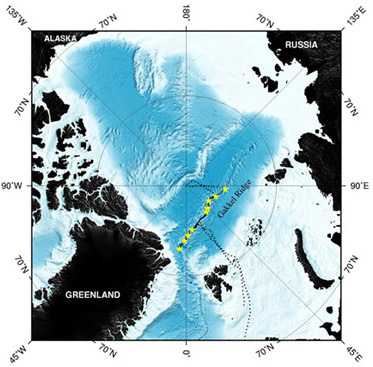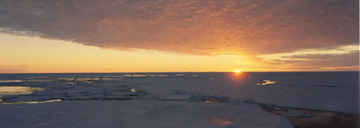Geotimes

Web
Extra Friday,
January 24
Arctic bounty of underwater
plumes
 The Arctic's
Gakkel Ridge has recently surprised oceanographers with signs of abundant hydrothermal
venting. Geological conditions and the heat or energy of a ridge determine how
much water can circulate through the crust and vent its way back to the ocean.
Generally, the slower the spreading ridge the cooler it is and the less it vents.
The Gakkel Ridge is the slowest of all, but its heat may provide it an extra
circulation boost. A reconnaissance study has identified plumes emanating from
at least nine to 12 discrete vents, more than twice as many as predicted for
this section of the Arctic Mid-Ocean Ridge.
The Arctic's
Gakkel Ridge has recently surprised oceanographers with signs of abundant hydrothermal
venting. Geological conditions and the heat or energy of a ridge determine how
much water can circulate through the crust and vent its way back to the ocean.
Generally, the slower the spreading ridge the cooler it is and the less it vents.
The Gakkel Ridge is the slowest of all, but its heat may provide it an extra
circulation boost. A reconnaissance study has identified plumes emanating from
at least nine to 12 discrete vents, more than twice as many as predicted for
this section of the Arctic Mid-Ocean Ridge.
"It's amazing," says chemical oceanographer Hedy Edmonds of the University
of Texas at Austin and lead author of the report about the find, which appeared
in the Jan. 16, Nature. "I've dreamed of getting to be the person
to look for hydrothermal activity on the Gakkel Ridge, and even to be asked
to go on the cruise was exciting," she says. "That there are so many
sites and so much evidence for venting is beyond my wildest expectations."
Map of the Arctic ocean floor, indicating
the Gakkel Ridge. The black dotted line is the cruise track of the Healy. Yellow
stars indicate the nine vent sites located during the AMORE expedition. Credit:
Hedy Edmonds.
The Gakkel Ridge lies on the seafloor near the North Pole and is a difficult
locality to explore, as only icebreakers or submarines are equipped to handle
the Arctic conditions at the surface while simultaneously investigating the
topography below.
Peter Michael of the University of Tulsa spent almost a decade planning the
2001 Arctic Mid-Ocean Ridge Expedition (AMORE) cruise, funded in part by the
National Science Foundation and the National Oceanic and Atmospheric Administration
(NOAA) Vents Program. The cruise sampled and surveyed more than a thousand kilometers
of the Gakkel Ridge using the U.S. Coast Guard Cutter Healy and German
PFS Polarstern icebreakers. Michael asked Edmonds to accompany him on
the cruise in an effort to learn what hydrothermal activity might be occurring
in the area.
 Every time a dredge
to collect rock samples went overboard, a miniature device went with it attached
to the cables, recording the temperature of the seawater and how much light
could penetrate the water at the various locations. Areas where the light could
not penetrate easily indicated suspended material in the water column, one sign
of a hydrothermal plume. When those areas also showed signs of warm water, the
plume was near to the vent. These clues allowed the oceanographers to map the
trail of plumes leading to the vent sites.
Every time a dredge
to collect rock samples went overboard, a miniature device went with it attached
to the cables, recording the temperature of the seawater and how much light
could penetrate the water at the various locations. Areas where the light could
not penetrate easily indicated suspended material in the water column, one sign
of a hydrothermal plume. When those areas also showed signs of warm water, the
plume was near to the vent. These clues allowed the oceanographers to map the
trail of plumes leading to the vent sites.
A Miniature Autonomous Plume Recorder
is deployed on a dredge wire. Below sunset on the Arctic. Photos by Hedy Edmonds.
In several locations conductivity, temperature and depth profiles, along with
measurements of manganese, a mineral linked with hydrothermal circulation, helped
Edmonds and her colleagues to confirm the location of nine vents along the ridge.
In some parts of the ridge the dredges themselves brought up hydrothermally
altered rocks.
The discovery is a strong reminder that the Arctic seafloor is still a region
full of mystery and that the rules on plate tectonics regarding hydrothermal
venting and spreading ridges are still being written. Says Julie Brigham-Grette
of the University of Massachusetts-Amherst: "Because practical logistics
and political access has limited research here, the unexpected is still what
we should expect from the arctic regions. It remains an exciting frontier in
the natural sciences."
Christina Reed
Links:
Arctic
Mid-Ocean Ridge Expedition cruise
January Geotimes
feature article: Investigaing an Arctic Gateway
Nature
 The Arctic's
Gakkel Ridge has recently surprised oceanographers with signs of abundant hydrothermal
venting. Geological conditions and the heat or energy of a ridge determine how
much water can circulate through the crust and vent its way back to the ocean.
Generally, the slower the spreading ridge the cooler it is and the less it vents.
The Gakkel Ridge is the slowest of all, but its heat may provide it an extra
circulation boost. A reconnaissance study has identified plumes emanating from
at least nine to 12 discrete vents, more than twice as many as predicted for
this section of the Arctic Mid-Ocean Ridge.
The Arctic's
Gakkel Ridge has recently surprised oceanographers with signs of abundant hydrothermal
venting. Geological conditions and the heat or energy of a ridge determine how
much water can circulate through the crust and vent its way back to the ocean.
Generally, the slower the spreading ridge the cooler it is and the less it vents.
The Gakkel Ridge is the slowest of all, but its heat may provide it an extra
circulation boost. A reconnaissance study has identified plumes emanating from
at least nine to 12 discrete vents, more than twice as many as predicted for
this section of the Arctic Mid-Ocean Ridge. 

